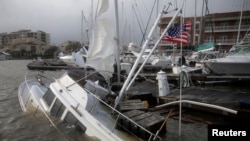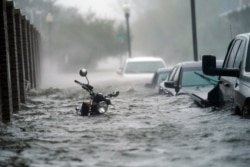More than 500,000 residents in the coastal areas of the states of Alabama and Florida were without power Thursday after Hurricane Sally blew over the region, leaving a trail of destruction.
Sally made landfall early Wednesday as a Category 2 hurricane near city of Gulf Shores, Alabama, and slowly made its way across the state and into Florida’s panhandle region. The storm’s 165 kilometer-per-hour winds and torrential rains flooded several small towns, knocked down power lines and destroyed homes and businesses.
Tony Kennon, the mayor of Orange Beach, Alabama, told news outlets the storm left one resident dead and another missing.
Emergency crews rescued at least 377 people in Escambia County, Florida, home to the popular vacation spot of Pensacola and a major naval air station, after Sally dumped as much as 61 centimeters of rain throughout the county. Escambia authorities announced a dusk-to-dawn curfew for the next three days. The storm also knocked out a portion of the newly constructed Three Mile Bridge that spans Pensacola Bay.
Sally later weakened to a tropical storm as it crossed the Florida border to the states of Georgia and South Carolina late Wednesday, eventually being downgraded to a tropical depression. But the National Hurricane Center says the remnants of Sally will produce as much as seven to 16 centimeters of rain in parts of Georgia, South Carolina, North Carolina, and Virginia.
Wednesday’s arrival of Hurricane Sally came exactly 16 years to the day that Hurricane Ivan struck the region as a Category 3 storm. Sally is the second storm to hit the Gulf Coast in less than three weeks.










